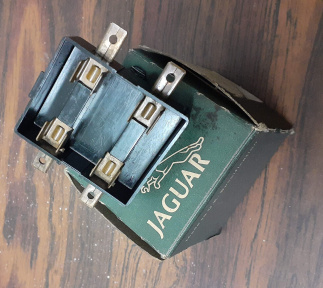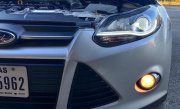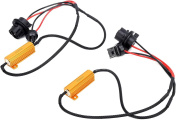
Bad fuses are a common cause of malfunctioning headlights. They rank high on the troubleshooting list. Whether you are a seasoned car owner or a newbie, it's important to know where to look for a blown fuse.
In most cars, fuses can be found either in the engine compartment or under the dashboard. The exact location varies from one car model to another. If you want to avoid playing hide-and-seek with your fuse box, check the manual or use the Internet to find its location.
But once you locate the fuse box, another question arises. Which of these brightly-colored fuses control your headlights? Let's go through everything step-by-step together.

How Do You Know Which Fuse Is For the Headlights?
The easiest way to identify the fuse that controls your headlights is to check the fuse diagram. Each vehicle has its unique fuse diagram. Be careful not to confuse it with another one online. It must be specifically for the model year of your vehicle.
You can find the diagram in your driver's manual or use online services and databases like Autofiles or others. Thankfully, all fuses are color-coded and sometimes vary in type and size. Using the diagram, you can easily pinpoint the exact fuse for your headlights.
There might be just one fuse for your headlights, or, depending on the model, there could be separate fuses for low-beam and high-beam headlights.
Usually, there is only one fuse for both the right and left headlights, regardless of whether they are high beams or low beams. If both lights go out simultaneously, chances are you have a blown fuse. This is easier and cheaper to fix than a blown headlight. If only one of your headlights goes out, then the issue isn't likely the fuse.
However, a blown fuse might indicate a larger yet unidentified problem. It might be due to faulty wiring or a damaged relay, and you'll still need to identify the underlying issue.
Is There a Fuse for Each Headlight?
While there isn't an individual fuse for each headlight, in certain car models, the headlight bulbs serve different functions. There can be separate fuses for Daytime Running Lights (DRLs), high beams, and low beams. To confirm this, consult your owner's manual and a fuse diagram.
The fuses you're looking for are most commonly located to the left of your steering wheel and below. However, that's not a rule, so verify the location using your manual or online resources to save time.
Once you locate and open the fuse box, you'll find a variety of fuses in different colors and sizes. You'll still need to have the diagram on hand.
If you're lucky, the fuse box's cover will have the diagram for you. By comparing it to the diagram, you'll know exactly where your headlight fuse is located.

How Do You Know If Your Headlight Fuse Is Blown?
Fuses protect your headlights from serious damage by taking it instead. You can identify a blown fuse by removing it and inspecting it. It will look melted, blackened, or burnt. Upon closer examination, you'll see that the metal element inside is broken in some way.
If, for some reason, visual inspection doesn't tell you much, there is another way. The only downside is that you must have a special tool for this. You can test the fuse with a multimeter or a test light to make sure that it's dead. Both are quite common tools, and they are more than affordable.
So, checking if the fuse is burnt out is pretty simple indeed. You can nail it the first time, even if you've never done this before. You just have to know what to look for.
Your cue to check the fuses is when both of your headlights are out. And when you switch the light bulbs between the left and the right headlight, nothing changes. This can actually mean that your fuse is no longer functional.
Do Headlights Have Their Own Fuse?
Yes, headlights do have their own fuse. For some car models, there are separate fuses for high beams and low beams. However, it's a common misconception that each headlight has a separate fuse.
You can find the headlight fuses inside the fuse box, usually located either in the engine compartment or on the left side of your dashboard. The second location can be harder to access, but with the right set of tools, it's feasible.
Just like any other crucial electrical element in your vehicle, your headlights are protected by fuses. These fuses are designed to blow before your headlights if something goes wrong. If you see that your fuses are blown, it's a clear signal to investigate further.
However, blown fuses usually hint at more serious issues, possibly with the wiring, the electrical system, or something else entirely. It's recommended to seek professional help when dealing with fuse problems. Only a thorough check can pinpoint the actual problem behind blown fuses and malfunctioning lights.
Is There a Fuse for Low Beam Lights?
That's right, low beams do have their own separate fuse. So if your low beams suddenly stop working but the high beams are just fine, that means you might have a blown fuse.
Look for your fuse box and search for the exact fuse that's connected to your low-beam headlights circuit. You can do that by consulting the owner's manual or a fuse diagram designed for your vehicle.
Next, remove the blown low-beam fuse and replace it. You can find the size and amperage inside the manual. It's very important to match those specifications.
But that's not the end, unfortunately. Fuses are pretty sturdy, they don't go out for no reason. It will have to find the issue that caused a power surge that scorched your fuse.
What Fuse to Use for Headlights?
If you look at your fuse box closely, you will notice that there are many colorful fuses of different shapes. And they all vary in amperage, wattage and size. So, which fuse works for headlights?
Typically, headlights use 30 amps fuses, but sometimes this specification varies depending on the headlights' wattage. For example, a 30 A fuse will work fine for a pair of 100-watt headlight bulbs. But as you know, LED headlights draw less power to produce light. So, a simple 5-amp fuse can do the trick.
There is also a method to calculate what size fuse you need for your headlights. Here's how you do it.
- Find out the load of your headlight bulbs combined. Because one fuse works with those headlights, left and right. For example, if you have 60-watt bulbs, multiply 60*2 to get the 120-watt load.
- Now, divide the load 120 watts by 12 volts and you will get a current draw of about 10 amps.
- You want your fuse to be slightly higher than that draw. Usually, it's around 125% of that number. So, you should be looking for 12,5 amp fuses. If you can find this size, scale up a little.
How Do You Test a Headlight Fuse?
Testing if your fuse works is quite simple. All you need to do is grab the right instrument, this time, it's a test light. It’s a pretty handy instrument and you should probably have it lying around somewhere.
- Step one is locating the fuse box. If it's not under your hood, it's probably under the dashboard to the left. If you don't want to go searching for it, check its location using your manual. You will need it anyways because it has the fuse diagram.
- Using the diagram find the location of your headlight fuse. It should be pretty easy if you are using the right diagram. Remember, they differ for each car model.
- Now, grab your test light and connect it to the negative battery terminal touch the positive terminal with the test light to see if it's working.
- Next to the same thing with both sides of the fuse in question. If one of the sides the test light does not light out, well, it's blown.
- You can remove the fuse and look at it closely. Usually, you can see that it's broken inside. There is a tiny metal part in the middle that becomes disconnected when the fuse burns out.
How To Replace a Headlight Fuse?
Replacing a blowing fuse is super easy. All you need to do for this is to know where your fuse box is located and how to find the right fuse connected to the headlights. All that can be done with a manual and a fuse diagram.
- First, turn off the engine obviously and disconnect the battery for your own safety.
- Open the fuse box and locate the faulty fuse.
- Take it out and take a closer look. A blown fuse usually has black spots and visible damage inside.
- Throw out the blown fuse and insert the new one. Make sure it's the same size. And that's it.









